I’ve gathered the top 15 edge‑AI camera modules that’ll shape smarter surveillance by 2025. These range from compact boards like the ESP32-S3-CAM and Arduino Nicla Vision to powerful platforms like the NVIDIA Jetson Orin NX and Yahboom Jetson Orin NX Development Kit. They excel in object detection, facial recognition, and real-time processing, perfect for security and industrial use. Stick with me, and I’ll guide you through each one and how they can meet your needs.
Key Takeaways
- The list includes compact modules like ESP32-S3-CAM and Arduino Nicla Vision suitable for real-time object detection and recognition.
- High-performance platforms such as NVIDIA Jetson Orin NX and Raspberry Pi AI Kit cater to demanding surveillance and industrial AI tasks.
- Connectivity options like Wi-Fi, Bluetooth, USB-C, and Ethernet support seamless integration into smart surveillance systems.
- Modules feature advanced AI capabilities including gesture recognition, facial detection, and thermal imaging for enhanced security.
- Limitations such as wiring challenges, limited onboard storage, and development complexity are addressed with suitable deployment considerations.
ESP32-S3-CAM Development Board with OV2640 Camera
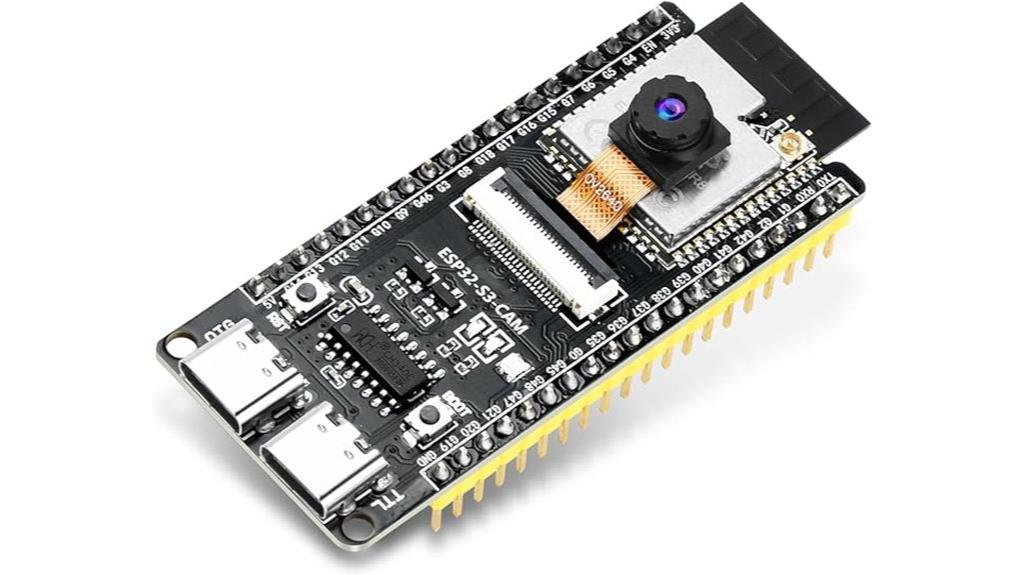
The ESP32-S3-CAM Development Board with OV2640 Camera is an excellent choice for developers and hobbyists seeking a compact, low-power edge-AI solution. It packs a dual-core 32-bit LX7 processor, delivering robust AI processing and real-time performance. The built-in 2-megapixel camera captures clear images and streams video instantly, perfect for smart surveillance or face recognition. Dual USB Type-C ports provide versatile connectivity for programming and debugging. Its Wi-Fi and Bluetooth 5 support ensure stable long-distance communication. Weighing just 0.5 ounces, it’s ideal for IoT, industrial, and robotics projects, even in high-temperature environments.
Best For: hobbyists, developers, and professionals looking for a compact, low-power edge-AI solution for smart surveillance, face recognition, and IoT projects.
Pros:
- Integrated 2MP OV2640 camera supports real-time video streaming and image capture.
- Dual USB Type-C ports enable versatile connectivity for programming and debugging.
- Supports Wi-Fi and Bluetooth 5 with long-distance communication features suitable for diverse environments.
Cons:
- Limited documentation and nonstandard wiring can complicate SD card mounting and setup.
- Inadequate support for Arduino IDE may require users to use ESP-IDF for advanced control.
- Customer reviews indicate challenges with SD card physical removal and overall usability.
Raspberry Pi AI Kit with M.2 HAT+, Hailo AI Module, and Accessories
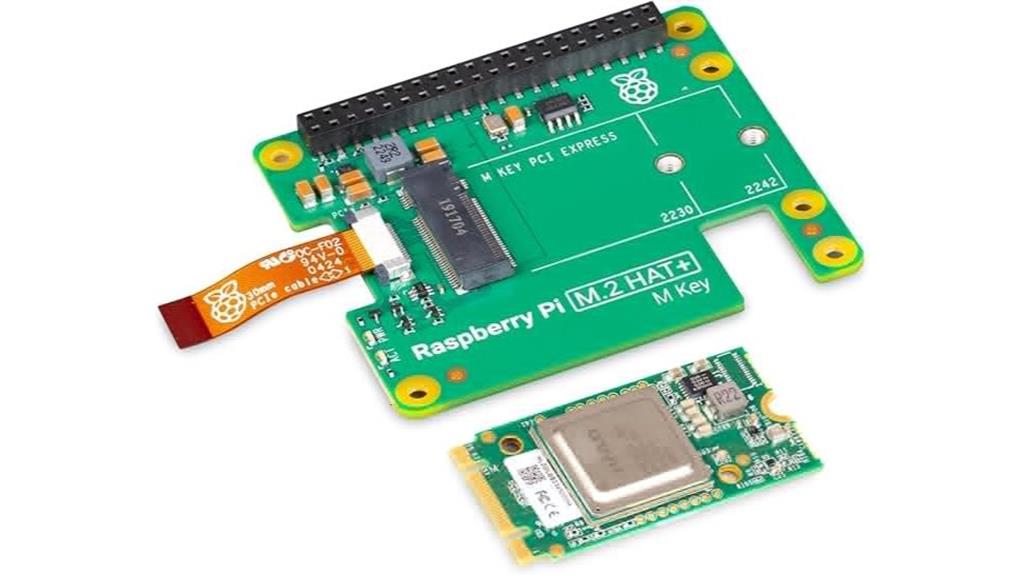
If you’re looking to build a compact, high-performance visual AI system, the Raspberry Pi AI Kit with M.2 HAT+ and Hailo AI Module is an excellent choice. It features a powerful 13 TOPS inference engine, thermal pad for cooling, and easy integration with Raspberry Pi 5. The kit supports YOLO object detection and can run models like Mistral 7B locally. Its hardware setup is straightforward, with accessories for mounting and cooling. While it’s ideal for image recognition and surveillance tasks, it’s not suited for large language models or chatbots. Overall, it offers a reliable, modular platform perfect for prototyping and deploying visual AI applications.
Best For: hobbyists, developers, and researchers seeking a compact, high-performance visual AI platform for image recognition, surveillance, and prototyping applications.
Pros:
- Powerful 13 TOPS inference engine that accelerates neural network tasks efficiently
- Seamless compatibility with Raspberry Pi 5 and Pi camera modules for easy setup
- Modular design with accessories for cooling and mounting, ideal for rapid prototyping
Cons:
- Not suitable for large language models or complex chatbot applications
- Potential hardware compatibility issues requiring careful cable selection and configuration
- Some users encounter difficulties with model compilation and software support for advanced AI workflows
Arduino Nicla Vision (ABX00051) – Compact AI Board with 5MP Camera and Edge Processing
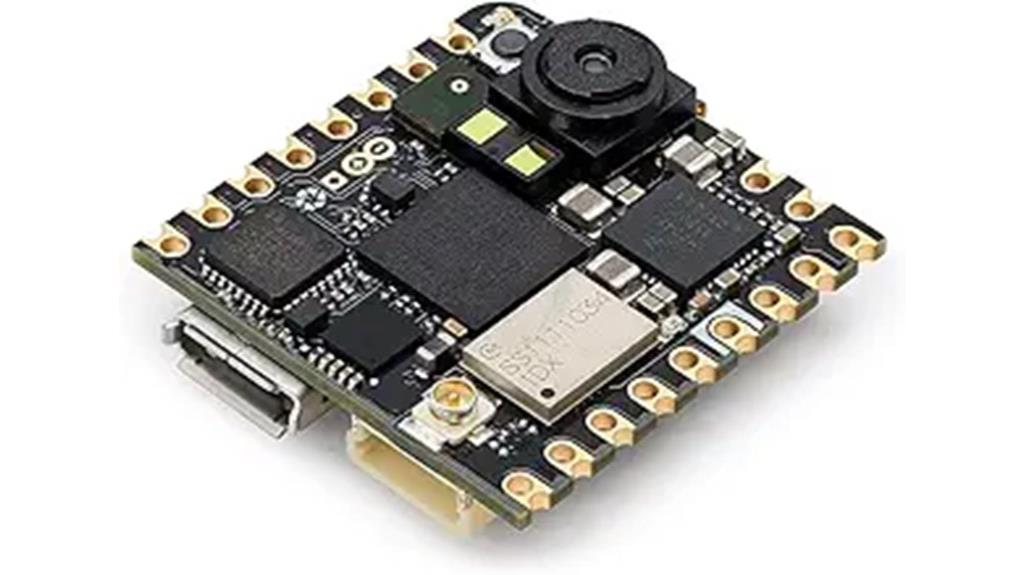
Designed for developers seeking compact, high-performance vision AI solutions, the Arduino Nicla Vision (ABX00051) stands out with its integrated 5MP camera and powerful Ambarella CV22 processor. Its small size makes it ideal for tight spaces and portable projects, while supporting real-time tasks like object recognition, facial detection, and motion tracking. The onboard Edge AI capabilities, powered by an Arm Cortex-M7, enable low-latency inference directly on the device, reducing reliance on cloud processing. With Wi-Fi, Bluetooth 5.1, and I2C connectivity, it’s perfect for IoT applications, security, and autonomous systems, offering efficient, low-power operation for smarter surveillance in 2025.
Best For: developers and engineers seeking a compact, high-performance AI board for real-time vision applications in IoT, robotics, and smart devices.
Pros:
- Compact and lightweight design ideal for tight spaces and portable projects
- Powerful Ambarella CV22 processor supports real-time vision tasks with low latency
- Multiple connectivity options (Wi-Fi, Bluetooth 5.1, I2C) for seamless integration
Cons:
- Limited to 5MP camera resolution, which may not suit high-detail imaging needs
- Requires familiarity with Arduino IDE and embedded development for optimal use
- Potentially higher cost compared to simpler sensor modules or microcontrollers
Gravity Offline Edge AI Gesture & Face Detection Sensor

For those seeking a privacy-focused solution, the Gravity Offline Edge AI Gesture & Face Detection Sensor stands out by processing all data locally without relying on cloud services. It recognizes five hand gestures and detects up to ten faces or upper-body presences within three meters, making it ideal for secure, real-time applications. Its integrated camera, onboard AI processor, and wide 85-degree field of view support reliable detection on walls, ceilings, or desks. Perfect for smart automation in sensitive environments like hospitals, bathrooms, or schools, it offers instant feedback with RGB indicators. Its compact, low-power design makes installation straightforward and preserves privacy without data storage or transmission.
Best For: privacy-conscious organizations and environments requiring secure, real-time gesture and face detection without cloud dependency.
Pros:
- Processes all data locally, ensuring complete privacy and compliance with strict data regulations
- Supports simultaneous recognition of 5 gestures and up to 10 faces within 3 meters for versatile applications
- Compact, low-power design with easy installation options suitable for various environments
Cons:
- Limited to recognizing only 5 hand gestures, which may not cover all user interaction needs
- Requires compatible platforms like Arduino, Raspberry Pi, or ESP32, possibly needing additional integration effort
- No built-in data storage or cloud features, limiting capabilities for historical data analysis or remote monitoring
Yahboom Jetson Orin NX Development Kit for AI Edge
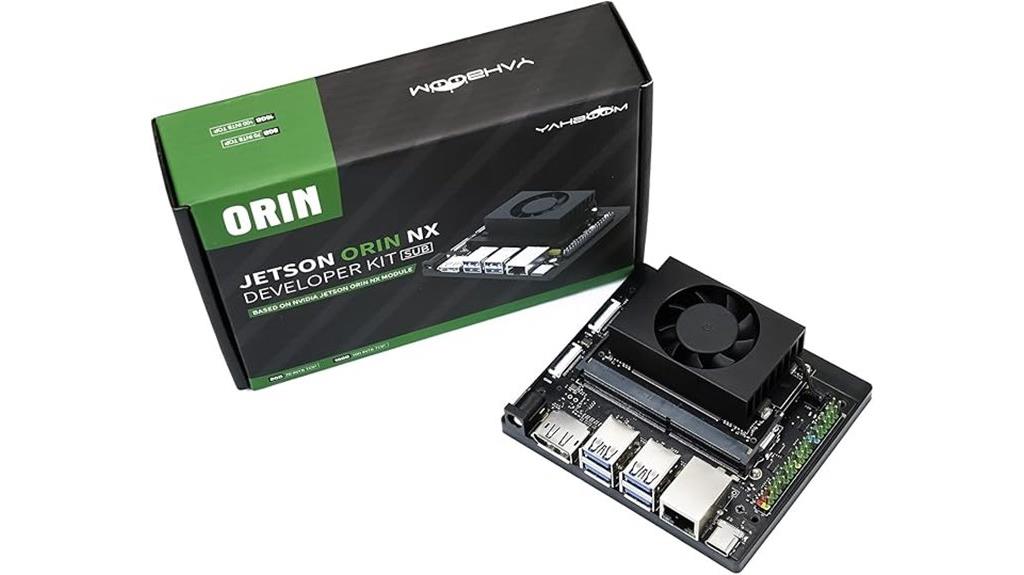
The Yahboom Jetson Orin NX Development Kit stands out as an ideal choice for advanced AI developers who need powerful edge processing capabilities. With 117 TOPS performance, a 1024-core NVIDIA Ampere GPU, and a 6-core ARM Cortex-A78AE CPU, it delivers exceptional speed for real-time AI tasks. Its 8GB LPDDR5 memory and support for external NVMe storage make it versatile for robotics, drones, and industrial applications. The kit includes a 15.6-inch 4K display, multiple USB ports, and various accessories, enabling all-encompassing AI development. While setup can be challenging, its high performance and industry flexibility make it a compelling platform for demanding edge-AI projects.
Best For: advanced AI developers and engineers seeking high-performance edge computing solutions for robotics, drones, and industrial applications.
Pros:
- Exceptional AI performance with 117 TOPS and a 1024-core NVIDIA Ampere GPU
- Versatile hardware supporting multiple peripherals, external storage, and high-resolution displays
- Suitable for complex, real-time AI tasks in demanding industrial and scientific environments
Cons:
- Challenging setup process requiring Linux and Python expertise
- Inconsistent or incomplete documentation and sample instructions
- Assembly and configuration can be difficult due to small parts and tight spaces
SingTown OpenMV Cam RT1062 AI Camera (5MP)
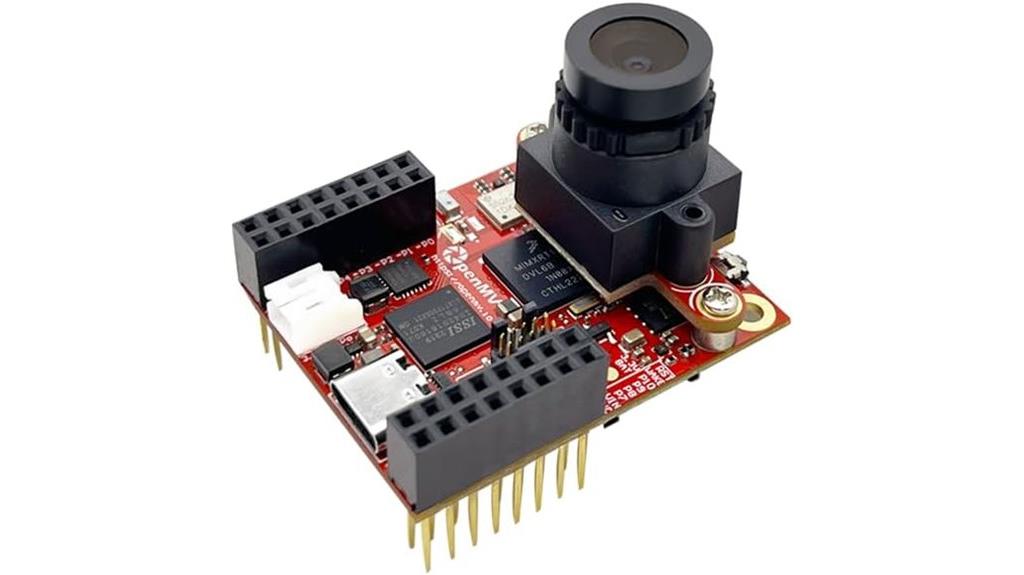
The SingTown OpenMV Cam RT1062 AI Camera (5MP) stands out with its powerful 600 MHz ARM Cortex-M7 processor, making it ideal for applications requiring fast, reliable machine vision. It features a 5MP OV5640 sensor with support for 2592×1944 resolution and can support up to 40 FPS at QVGA. Its versatile interfaces—USB-C, WiFi, Bluetooth, and Ethernet—allow seamless integration into various IoT and robotics projects. With 14 I/O pins supporting multiple protocols and low power consumption, it’s perfect for industrial automation and surveillance. Its customizable modules, including options for global shutter or thermal imaging, expand its versatility for smarter security solutions.
Best For: professionals and developers seeking a high-performance AI camera for robotics, industrial automation, and IoT applications that require fast image processing and versatile connectivity.
Pros:
- Equipped with a powerful 600 MHz ARM Cortex-M7 processor and high-resolution 5MP sensor for reliable, high-speed machine vision.
- Supports multiple connectivity options including USB-C, WiFi, Bluetooth, and Ethernet, enabling seamless integration.
- Features customizable modules such as global shutter and thermal imaging for diverse application needs.
Cons:
- May have a higher cost compared to basic camera solutions due to its advanced features.
- Limited onboard storage (16MB flash), requiring external storage solutions for extensive data logging.
- Complex setup and configuration might require technical expertise for optimal use.
Seeed Studio Grove Vision AI Module with Himax HX6537-A Processor and OV2640 Camera
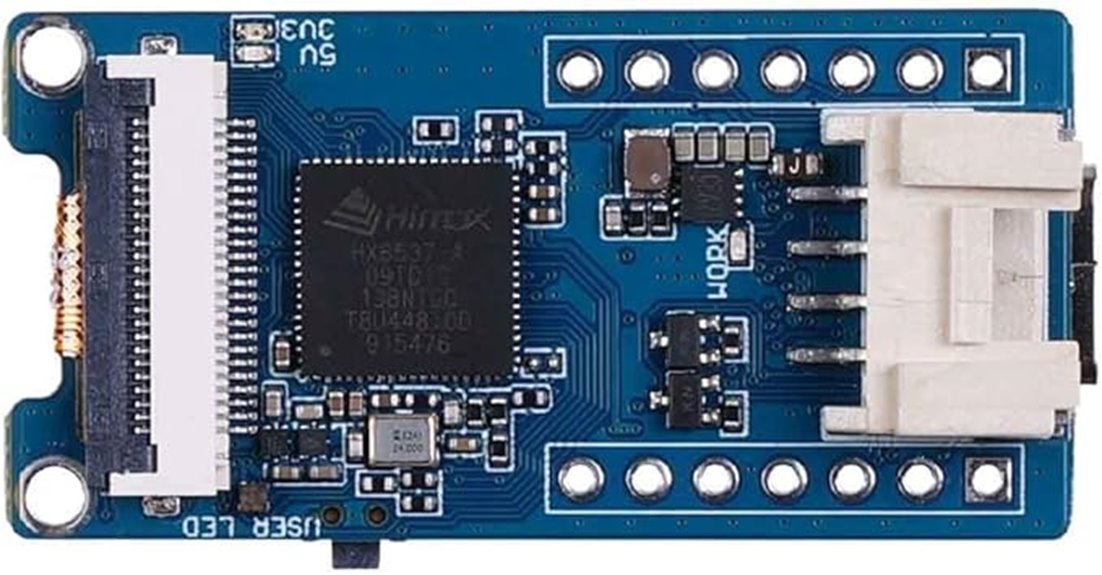
If you’re looking for a compact and versatile edge-AI camera solution, the Seeed Studio Grove Vision AI Module stands out thanks to its Himax HX6537-A processor and OV2640 camera. It supports auto-exposure and auto-white balance for clear images and can import up to three custom models for tasks like object detection and face recognition. Compatible with XIAO, Raspberry Pi, and Arduino, it’s easy to integrate into various projects. Using YOLOv5, it recognizes multiple objects in real-time, with development simplified through Arduino IDE and drag-and-drop model deployment. This module is ideal for smart surveillance and AI-powered vision applications.
Best For: developers and hobbyists seeking a compact, easy-to-integrate AI vision module for object detection, face recognition, and smart surveillance projects.
Pros:
- Supports importing up to three custom AI models for versatile applications.
- Compatible with popular platforms like XIAO, Raspberry Pi, and Arduino via Grove connector.
- Utilizes YOLOv5 for real-time, multi-object detection with simplified development through Arduino IDE.
Cons:
- Limited to three custom models at a time, which may restrict complex project needs.
- Requires familiarity with AI models and development environments for optimal use.
- Might have limited processing power for highly demanding AI tasks compared to larger solutions.
Waveshare Jetson Orin Nano Development Kit with 8GB Memory
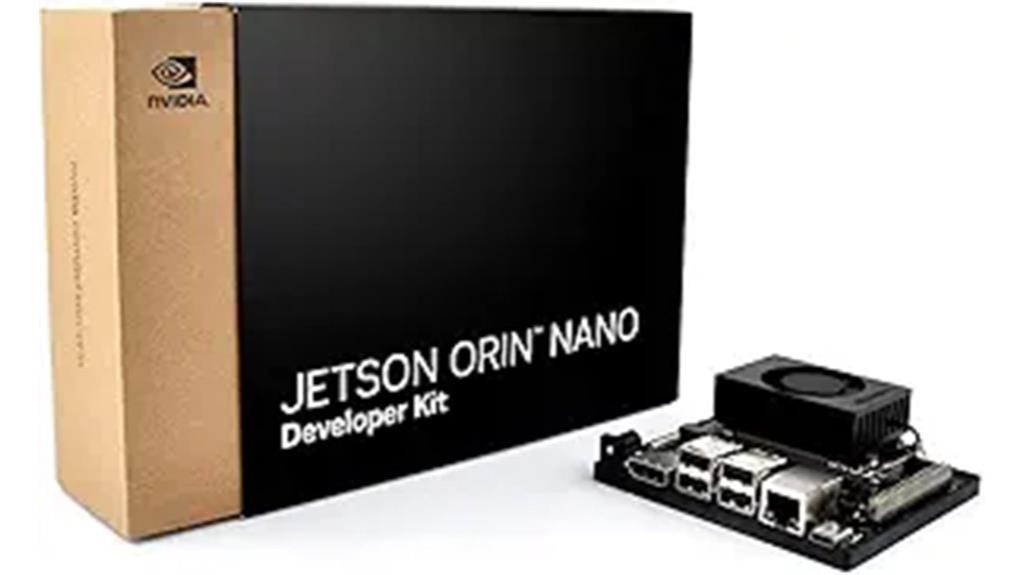
For developers seeking a compact yet powerful platform, the Waveshare Jetson Orin Nano Development Kit with 8GB Memory offers an ideal solution. It features the Jetson Orin Nano Module, supporting all modern AI models like Vision Transformers and Large Language Models. With up to 67 TOPS of AI performance and boosted memory bandwidth of 102GB/s, it delivers significant processing power in a small form factor. The kit is upgradeable via software, making it accessible for students, hobbyists, and professionals alike. Waveshare provides full support and warranty, ensuring a reliable, cost-effective choice for edge AI projects in smarter surveillance applications.
Best For: developers, students, and hobbyists seeking a compact, high-performance AI development platform for edge and embedded systems.
Pros:
- Supports all modern AI models including Vision Transformers, LLMs, and VLMs.
- Offers up to 67 TOPS of AI performance with boosted memory bandwidth of 102GB/s.
- Fully upgradeable via software, with full warranty and support from Waveshare.
Cons:
- May require technical knowledge for setup and optimization.
- Limited to the specifications of the Jetson Orin Nano Module; not suitable for extremely high-end AI workloads.
- Availability depends on purchasing directly through Waveshare to ensure warranty and support.
Seeed Studio NVIDIA Jetson Orin NX 16GB Edge AI Device
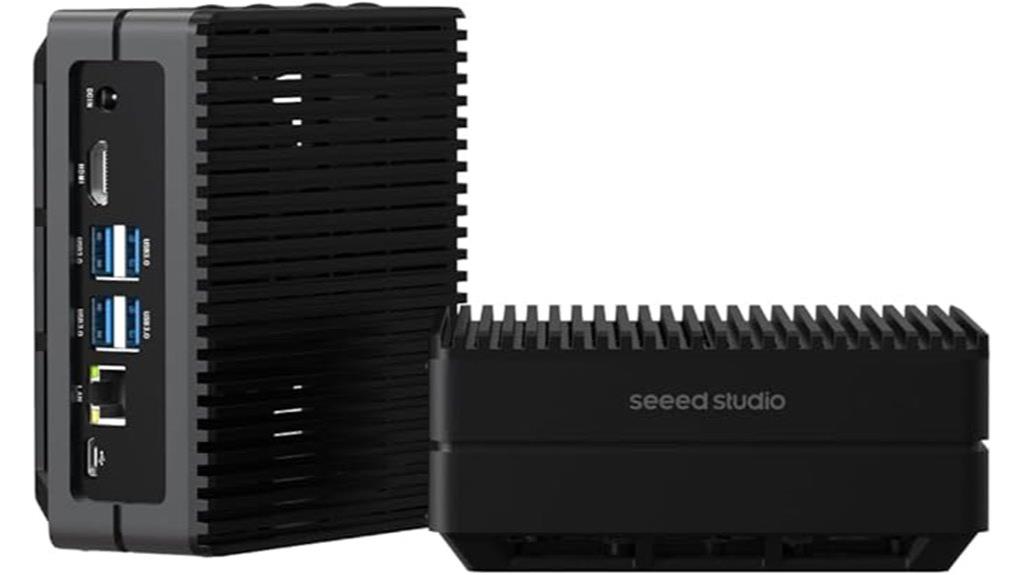
Designed for demanding edge AI applications, the Seeed Studio NVIDIA Jetson Orin NX 16GB device delivers up to 100 TOPS of AI performance while maintaining low power consumption and minimal latency. It supports Super mode via JetPack 6.2, boosting thermal efficiency for intensive AI tasks. Its compact size (130mm x 120mm x 58.5mm) includes a cooling fan, heatsink, enclosure, and power adapter, making it versatile for various deployment environments like desktops or wall mounts. With rich I/O options—USB, HDMI, CSI, GbE, M.2, and GPIO—it’s highly expandable. Pre-installed with Jetpack 5.1 and a 128GB NVMe SSD, it’s ready for rapid AI deployment.
Best For: professionals and developers seeking a compact, high-performance edge AI device for demanding applications like robotics, industrial automation, or intelligent surveillance.
Pros:
- Up to 100 TOPS AI performance with low power and minimal latency.
- Compact design (130mm x 120mm x 58.5mm) suitable for diverse deployment environments.
- Rich I/O options including USB, HDMI, CSI, GbE, M.2, and GPIO for versatile connectivity.
Cons:
- Power adapter sold separately, adding to initial setup costs.
- Requires technical expertise for optimal configuration and integration.
- Limited to 16GB RAM, which may be insufficient for extremely large AI models or data sets.
Youyeetoo D-Robotics RDK X5 Development Board (8GB RAM)

The Youyeetoo D-Robotics RDK X5 Development Board with 8GB RAM stands out as an ideal solution for advanced edge-AI camera applications that demand high processing power and versatile connectivity. Its octa-core Cortex A55 CPU at 1.5GHz and 10 TOPS BPU ensure robust AI performance, while the 32 Gflops GPU handles graphics efficiently. With dual MIPI CSI interfaces and support for 1080p60 video output, it’s perfect for high-resolution imaging. The board offers extensive connectivity options, including Wi-Fi 6, Bluetooth 5.4, Gigabit Ethernet with PoE, and multiple USB ports. Pre-installed with Ubuntu 22.04, it’s ready for rapid deployment in multimedia, imaging, and AI projects.
Best For: developers and engineers seeking a high-performance edge-AI development platform for multimedia, imaging, and advanced AI applications.
Pros:
- Robust processing power with octa-core Cortex A55 CPU and 10 TOPS BPU for AI acceleration
- Versatile connectivity options including Wi-Fi 6, Bluetooth 5.4, Gigabit PoE Ethernet, and multiple USB ports
- Supports high-resolution video output and dual MIPI CSI interfaces ideal for imaging and multimedia projects
Cons:
- May require technical expertise for optimal setup and integration
- Higher cost compared to less feature-rich development boards
- Limited to 8GB RAM options, which might be restrictive for extremely large AI models
Raspb Pi 5 AI Kit (PI5-8GB)
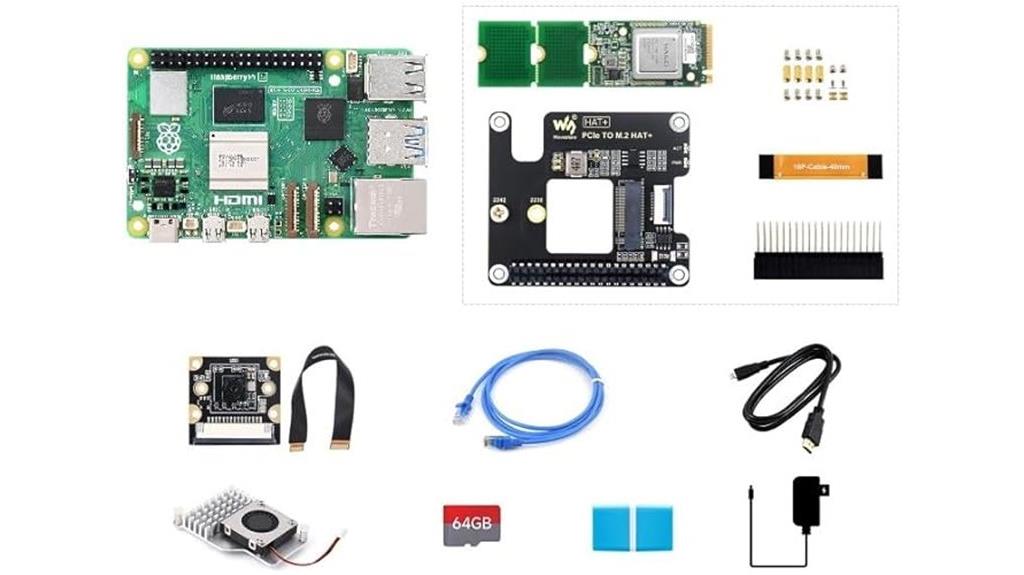
The Raspb Pi 5 AI Kit (PI5-8GB) stands out as an ideal solution for developers and innovators seeking high-performance edge AI processing. Its powerful 2.4GHz quad-core Arm Cortex-A76 CPU, combined with an Hailo-8 AI accelerator supporting 26 TOPS, enables real-time, low-latency AI inference. With 8GB of RAM and dual 4K HDMI outputs, it handles complex multimedia tasks efficiently. The kit includes essential accessories like a camera, cooler, and storage, making deployment straightforward. Its versatile connectivity options—Wi-Fi, Ethernet, USB, PCIe—support diverse surveillance applications. Overall, this kit offers a compact yet robust platform for smarter, faster edge AI in surveillance systems.
Best For: developers and innovators seeking a high-performance, low-latency AI edge computing platform for complex multimedia and surveillance applications.
Pros:
- Powerful 2.4GHz quad-core Cortex-A76 CPU combined with a Hailo-8 AI accelerator supporting 26 TOPS for rapid AI inference.
- Supports dual 4Kp60 HDMI outputs and multiple AI frameworks, enabling versatile multimedia and AI development.
- Includes essential accessories like a camera, cooler, and storage, facilitating quick deployment and comprehensive edge AI solutions.
Cons:
- The kit requires technical expertise to set up and optimize AI models effectively.
- Limited to specific AI frameworks and may need additional configuration for custom applications.
- The hardware form factor and power requirements may pose challenges for certain embedded or portable use cases.
Youyeetoo RISC-V Development Kit with K510 AI Chip
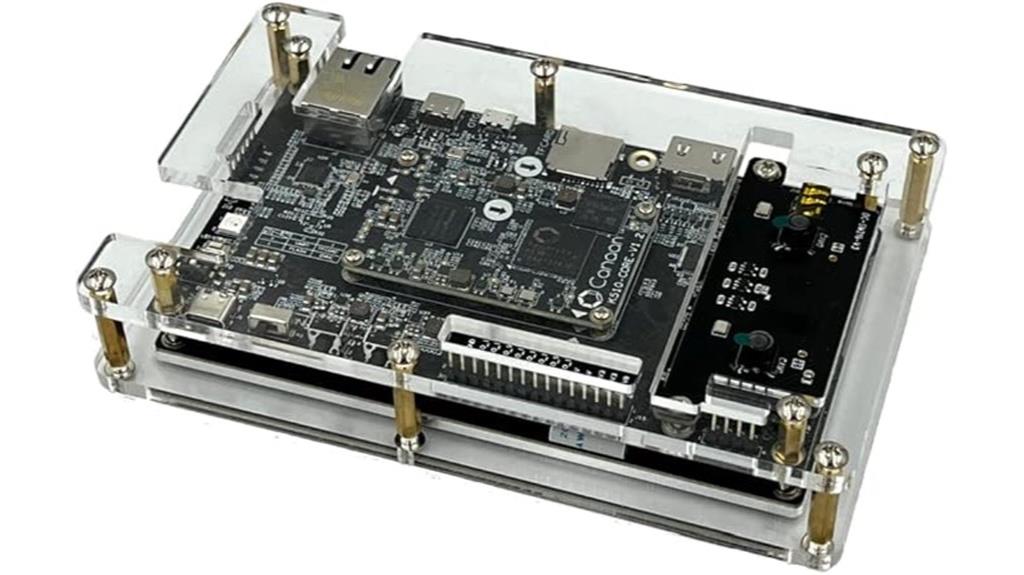
If you’re developing edge-AI applications that demand high-performance processing in a compact form, the Youyeetoo RISC-V Development Kit with K510 AI Chip is an excellent choice. It features a second-generation K510 AI chip capable of 2.5 Tops, with KPU2.0 for three times the performance of K210. The kit supports advanced image processing, TOF depth cameras, and hardware 3A functions. Its modular design and Linux OS make secondary development straightforward. With open-source SDKs, demo projects, and extensive documentation, it’s perfect for drones, robotics, and intelligent cameras. Plus, Bluetooth connectivity and accessory support guarantee versatile deployment and rapid prototyping.
Best For: developers and engineers seeking high-performance, compact edge-AI solutions for robotics, drones, and intelligent camera projects.
Pros:
- Powerful second-generation K510 AI chip with 2.5 Tops processing capacity for demanding applications
- Modular hardware design and Linux OS facilitate easy secondary development and customization
- Extensive open-source SDKs, demo projects, and comprehensive documentation support rapid prototyping and deployment
Cons:
- Requires familiarity with Linux and embedded development environments, potentially challenging for beginners
- Limited to specific accessories and peripherals compatible with the kit, which may restrict certain customizations
- Availability and pricing may vary depending on regional distribution channels and online platforms
reComputer Industrial J3010 Edge AI Device with Jetson Orin Nano 4GB
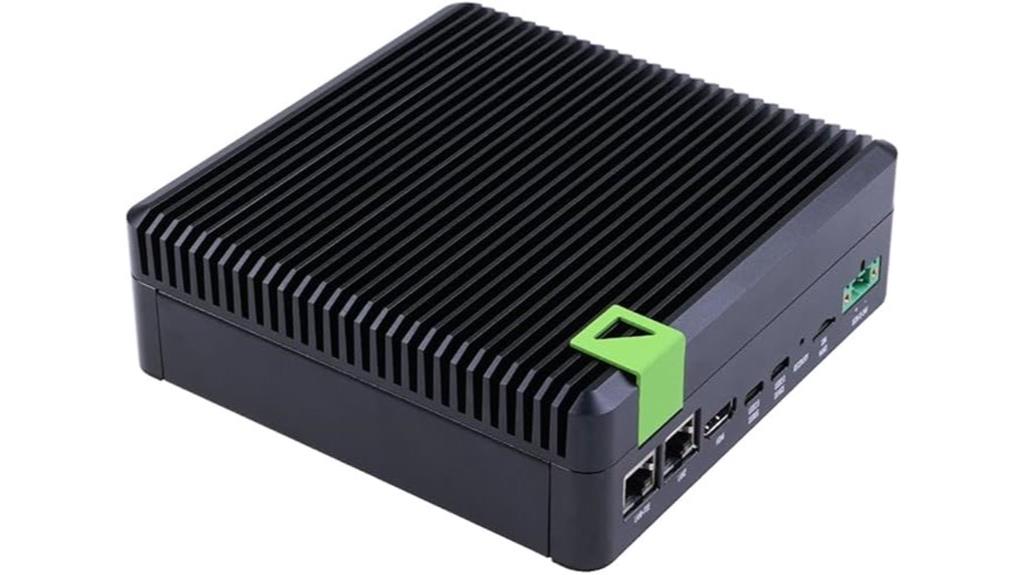
Designed for industrial environments that demand reliable and silent operation, the reComputer Industrial J3010 Edge AI Device with Jetson Orin Nano 4GB offers robust passive cooling in an aluminum case, making it ideal for harsh conditions. Its fanless design guarantees silent operation, while the aluminum case provides excellent heat dissipation. Supporting a wide temperature range from -20°C to 60°C, it’s built for challenging environments. Equipped with a Jetson Orin Nano 4GB module, it delivers powerful AI capabilities. With multiple industrial interfaces, 5G/4G/LTE support, and flexible mounting options, this device seamlessly integrates into demanding surveillance setups.
Best For: industrial professionals and system integrators seeking a reliable, silent, and rugged edge AI device for harsh environments and demanding surveillance applications.
Pros:
- Fanless design ensures silent operation and reduces maintenance needs.
- Wide temperature support (-20°C to 60°C) suitable for challenging outdoor or industrial settings.
- Robust industrial interfaces and flexible mounting options facilitate seamless integration.
Cons:
- Power adapter sold separately, potentially increasing initial setup costs.
- Limited 4GB RAM may restrict very high-demand AI workloads.
- First available date is in July 2024, which may delay immediate deployment.
Waveshare Jetson Orin NX AI Development Kit with 16GB Memory

For developers seeking high-performance edge AI solutions, the Waveshare Jetson Orin NX AI Development Kit with 16GB memory stands out due to its impressive 100 TOPS processing power. This kit includes the Jetson Orin NX module, an IMX219-77 camera, and a JETSON-IO-BASE-B baseboard, making it ideal for advanced AI applications. It offers a 128GB NVMe SSD for fast storage, supporting large AI projects. With built-in wireless connectivity via Bluetooth 5.0 and dual-band Wi-Fi, plus extensive interfaces like M.2, HDMI, and USB, it provides flexibility for diverse surveillance and AI tasks at the edge.
Best For: developers and engineers seeking a high-performance, edge AI development platform for advanced AI applications and projects.
Pros:
- Delivers up to 100 TOPS AI processing power for demanding AI tasks
- Includes a 128GB NVMe SSD for fast, large-capacity storage
- Rich peripheral interfaces like M.2, HDMI, and USB for versatile expansion
Cons:
- No built-in storage module included, requiring additional storage setup
- May require technical expertise for optimal configuration and integration
- Appearance of SSD may vary, potentially affecting initial setup or branding
ESP32-P4 Smart Development Board with Touch Display

The ESP32-P4 Smart Development Board with Touch Display stands out as an ideal choice for developers seeking high-performance edge-AI solutions with an intuitive interface. Its onboard ESP32-P4 chip, featuring dual-core RISC-V processors, delivers robust processing power for AI vision and voice applications. The 4-inch IPS touchscreen with 720×720 resolution and 5-point touch makes interaction seamless. Supporting external cameras and advanced multimedia codecs, it’s perfect for scenario-based control, smart IoT, and human-machine interaction. Built-in security features like secure boot, flash encryption, and cryptographic accelerators ensure data safety. Plus, Wi-Fi 6 connectivity guarantees reliable, high-speed wireless communication for demanding edge deployments.
Best For: developers and engineers seeking a high-performance, secure, and versatile edge-AI platform for IoT, human-machine interaction, and scenario-based control applications.
Pros:
- Powerful dual-core RISC-V processors enable advanced AI vision and voice processing capabilities.
- 4-inch IPS touchscreen with high resolution and multi-touch support offers intuitive user interaction.
- Comprehensive security features, including secure boot, flash encryption, and cryptographic accelerators, ensure data safety.
Cons:
- Limited physical dimensions may restrict integration into compact or space-constrained environments.
- Price and availability may vary, potentially impacting project planning and budgeting.
- Requires familiarity with embedded development and AI integration for optimal use.
Factors to Consider When Choosing Edge‑Ai Camera Modules
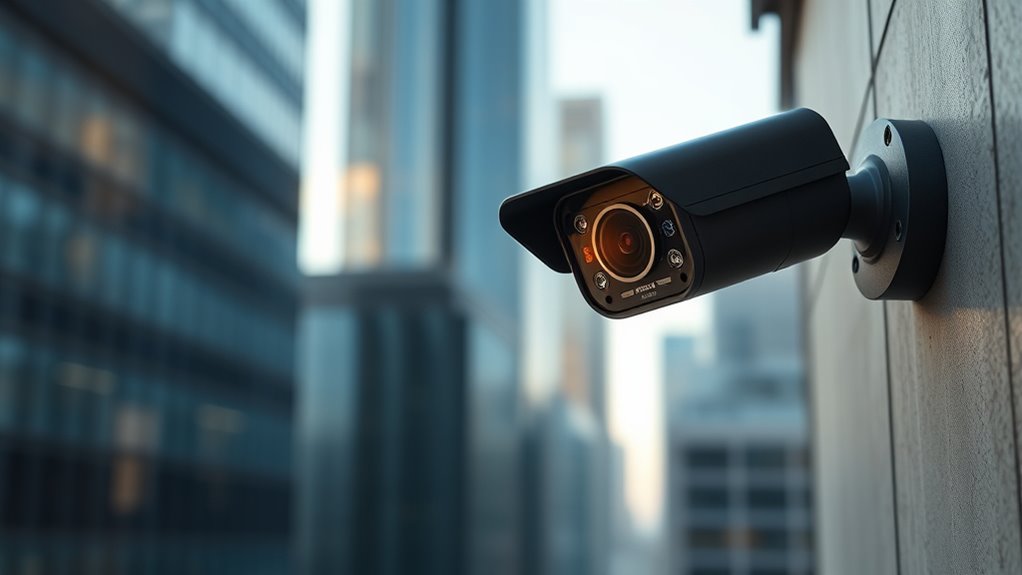
When selecting an edge-AI camera module, I focus on factors like processing power, connectivity options, and power consumption to meet my project’s needs. I also consider camera resolution quality and software support to guarantee compatibility and performance. Making the right choices here helps me build efficient and reliable edge solutions.
Processing Power Needs
Choosing the appropriate processing power for edge-AI camera modules is vital because it directly affects their ability to perform complex tasks like object detection and facial recognition in real time. Higher processing capabilities enable devices to analyze video data locally, reducing latency and reliance on cloud services. Advanced AI processors, such as neural inference accelerators, handle larger, more sophisticated models, supporting high frame rates necessary for fast-moving scenarios. However, increased processing power often means higher energy consumption, which matters for battery-powered or low-power setups. It’s also important to take into account thermal management and physical size, ensuring the module remains reliable and suitable for compact or embedded environments. Striking the right balance ensures peak performance without compromising device longevity or integration.
Connectivity Options Available
Selecting the right connectivity options for edge-AI camera modules is essential because it directly impacts data transfer speed, system stability, and integration flexibility. These modules support various interfaces like Wi-Fi, Bluetooth, Ethernet, USB, and GPIO, allowing tailored integration for different applications. Wireless protocols such as Wi-Fi 6 and Bluetooth 5.1/5.4 enable high-speed, low-latency data transfer crucial for IoT setups. Wired options like Ethernet and USB provide stable, high-bandwidth connections ideal for real-time video streaming and AI processing. Compatibility with interfaces like I2C, UART, and SPI ensures seamless connection with sensors and controllers. Ultimately, your choice influences power consumption, transfer speed, range, and ease of system integration, making it a pivotal factor in deploying effective, reliable edge-AI surveillance solutions.
Power Consumption Levels
Ever wondered how edge-AI camera modules balance performance with energy efficiency? It’s a essential factor, especially for devices operating on batteries or in energy-sensitive environments. Many models incorporate smart power management techniques like dynamic voltage and frequency scaling, which cut energy use during idle or low-activity periods. Power consumption can vary widely—from as little as 30µA in deep sleep mode to several watts during intense processing or high-resolution streaming. Choosing a camera with optimized hardware, such as efficient processors and low-power sensors, helps keep energy use minimal without sacrificing performance. Striking the right balance ensures the device runs continuously, avoiding overheating or premature power drain. This careful management is indispensable for reliable, long-term surveillance solutions.
Camera Resolution Quality
When evaluating edge-AI camera modules, resolution quality plays a crucial role in determining their effectiveness for specific applications. Higher resolutions, like 5MP or 8MP, capture more detailed images, enhancing accuracy in AI tasks such as facial recognition and object detection. Clearer images improve model performance during training and inference, especially in complex environments. However, increased resolution demands more processing power and bandwidth, affecting hardware and network choices. The ideal resolution depends on the application—low-res cameras may suffice for presence detection, while detailed inspections require higher resolutions. Striking a balance among resolution, frame rate, lighting, and environment ensures reliable and efficient AI processing, making resolution quality a critical factor in selecting the right edge-AI camera module.
Software Compatibility Support
How well a camera module supports popular development environments and AI frameworks can considerably impact its integration and performance. Ensuring compatibility with platforms like Arduino IDE, Raspberry Pi OS, or Linux makes setup smoother and reduces development time. It’s also essential to verify that the module works with AI frameworks such as YOLO, TensorFlow, PyTorch, or OpenCV, depending on your project needs. Look for available SDKs, APIs, and extensive documentation, which simplify programming, model deployment, and updates. Regular firmware and software updates from the manufacturer are critical for security and new features. Additionally, check if the module facilitates easy import and deployment of custom AI models, supporting model conversion, optimization, and hardware compatibility, to maximize your surveillance system’s intelligence and flexibility.
Environmental Suitability
Are you confident that your edge-AI camera module can withstand the environmental conditions of its intended deployment? Verifying compatibility starts with checking the device’s temperature range to avoid performance issues or damage. Check for environmental certifications like IP ratings, which indicate resistance to dust, water, and other contaminants. If your camera will be outdoors or exposed to high humidity, it must resist moisture to guarantee reliable operation. Ruggedness is also essential—consider shock and vibration resistance if used in industrial or mobile settings. Finally, confirm the module’s ability to operate effectively under specific conditions, such as extreme temperatures or exposure to dust and chemicals. Proper environmental suitability guarantees durability and consistent performance, making your surveillance system both reliable and long-lasting.
Frequently Asked Questions
How Do Edge-Ai Cameras Handle Data Privacy Concerns?
When I think about how edge-AI cameras handle data privacy, I realize they process data locally, right on the device. This means sensitive information doesn’t have to travel to the cloud, reducing exposure risks. Plus, many come with encryption and secure access controls. I appreciate that these measures help protect privacy while still allowing the cameras to provide smart, real-time surveillance without compromising personal data.
What Is the Typical Power Consumption of These Modules?
The typical power consumption of edge-AI camera modules varies depending on their design and features, but generally, they use between 5 to 15 watts. I find that newer models are becoming more energy-efficient, balancing advanced processing capabilities with lower power use. This reduction helps in deploying these cameras in remote or power-sensitive locations. Overall, understanding power needs is key to optimizing surveillance setups without compromising performance.
How Scalable Are These AI Camera Solutions for Large Systems?
Imagine building a towering skyscraper; scalability depends on solid foundations. These AI camera solutions are highly scalable, like flexible branches that grow with your needs. I’ve seen systems expand seamlessly from handfuls to thousands of units, thanks to modular designs and cloud integration. This flexibility guarantees you can adapt to any surveillance challenge, making your system as dynamic and resilient as your ambitions require.
Can These Modules Integrate With Existing Security Infrastructure?
When considering integration with existing security systems, I find that many edge-AI camera modules are designed for compatibility. They often support standard protocols like ONVIF and RTSP, making setup smoother. I always check if the modules can connect seamlessly with current infrastructure—this saves time and reduces costs. Overall, most modern modules are adaptable, but I recommend verifying compatibility before purchasing to guarantee smooth integration.
What Are the Real-Time Processing Capabilities of Each Module?
Ah, the thrill of real-time processing—truly the heart of smarter surveillance. I’ve seen modules that analyze footage in milliseconds, practically giving you eyes everywhere, instantly. Others may lag behind, like watching paint dry. Honestly, it’s impressive how some modules handle facial recognition, motion detection, and alerts seamlessly, while a few still stumble. So, if speed and accuracy matter, I’d choose the ones that process data faster than you can say “security breach.”
Conclusion
Just like the heroes in our favorite stories, choosing the right edge-AI camera module can transform your surveillance into a vigilant guardian. Whether you’re building a smart security system or enhancing industrial monitoring, these options are your trusty sidekicks. Remember, the right device not only sees but understands. So, as I’ve explored these top picks, I invite you to find your own modern-day sentinel—ready to protect and serve in 2025.










